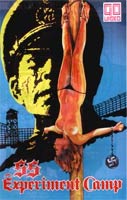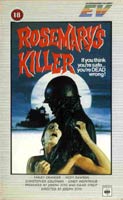|
Page one / Page two
/ Page three
Whilst at the time the whole video nasties furore seemed extraordinary,
in hindsight it should have surprised nobody. The Establishment
has always viewed new media, particularly those embraced by a younger
generation, with a great deal of suspicion. Obscenity trials against
theatrical shows like Oh! Calcutta and the satirical magazine Oz
in the late 1960’s provide a depressing nod towards the events
of the early 1980’s. These moral whirlwinds also blow up during
times of acute social or political difficulties, so when the new
media of video finally began to gain mass acceptance in the early
1980’s, a time of high unemployment, race riots, economic
recession and rising crime, the scapegoating of videos as public
enemy number one was almost destined to be. The whole episode is
also a salutary lesson in the power of minor interest groups to
inform public policy, providing they have powerful friends and are
prepared to embellish the facts with a healthy dollop of hysteria.

The fact that the video industry, in its infancy in the UK and
effectively unregulated, did itself no favours with lurid advertising
campaigns and publicity stunts is beside the point. The explosion
of video ownership created hundreds of new labels, often operating
out of garages and tiny provincial towns, that were unable to acquire
the rights to big-budget Hollywood movies so, in order to service
the growing demand for videos, ended up releasing material that
had never previously been released in the UK. Today, the market
is dominated by the video arms of the major Hollywood studios. In
1981, major studios were deeply suspicious of the new medium and
slow to get in the game, there were no big fish in the pond, only
lots of small fry. Labels like Iver Film Services, Intervision,
VTC (with their natty gold sleeves), and World of Video 2000 (which
should have been World of Video 1984, about the time it ceased trading)
sprung up and died almost overnight. With them came a wacky variety
of non-mainstream material available on the cheap.
Along side the Brotherhood of Man concert videos, Childrens Film
Foundation movies and Greek westerns that found their way into British
living rooms, was a growing number of horror movies, many continental,
and many too obscure, too dismal or too violent ever to receive
a British theatrical release. Horror films were immediately popular
on home video – and the fact that videos did not require a
BBFC certificate meant that all manner of material was available
in your local garage, corner shop or out of the back of a white
van that would never have passed the BBFC's vetting procedure had
they been released theatrically.
For a couple of years as the home video explosion continued unabated
everyone was happy, or so it seemed. The industry was Thatcher’s
free market sink-or-swim economics in a nutshell, with labels seemingly
appearing overnight and going out of business the next month, living
or dying on the quality of the product they had been able to acquire,
as all the while the big Hollywood studios stood back and watched.
It was as competition in the video marketplace grew massively and
companies began to resort to ever more lurid publicity campaigns,
when the first cracks in the new industry began to show and things
started to go wrong.

Go Video’s decision to supply Mary Whitehouse with a copy
of Cannibal Holocaust must go down as one of the greatest publicity
own-goals of all time, but it was by no means the only one. The
distributors of a little known American slasher flick called ‘NIGHTMARE’
re-named it ‘NIGHTMARES IN A DAMAGED BRAIN’
and ran a ‘guess the weight of the brain in a jar’ competition.
Astra home video released ‘SNUFF’ without
credits and with box art suggesting it was a real snuff video (which
it patently is not) and were forced to withdraw the release after
one day. Over-the-top advertising for movies like SS EXPERIMENT
CAMP and CANNIBAL FEROX in the video trade
press (and on posters outside video shops – the one in my
local town was forced to remove a poster for FLESH FOR FRANKENSTEIN
after complaints) resulted in the powers that be, pushed by the
hysterical ranting of Mary Whitehouse’s National Viewers and
Listeners Association, taking more of an interest in the extreme
end of the video market. At one point, Mrs Whitehouse complained
to the newspapers that video ‘could be the biggest threat
to the quality of life in Great Britain’. Comparing the impact
of I MISS YOU HUGS AND KISSES with the discovery
of a new and potentially devastating virus called HIV, massive levels
of unemployment, the threatened Miners Strike or the civil disorder
in places like Toxteth, Moss Side and Brixton is patently ludicrous
even without the benefit of hindsight and anyone with half a brain
could see this as rampant and groundless hyperbole based on self-publicity.
Which brings us to politicians.
It is ironic that in the same year as THE EVIL DEAD
topped the yearly video rental charts in the UK (and incidentally
the same year as a General Election – draw your own conclusions),
politicians and the mass media began a campaign to ban what euphemistically
became known as video nasties. Initially, politicians were reticent
about the industry (It was, after all both a money spinner for VAT
and a place where a daring business could make a lot of money quickly),
but organisations like the NVLA had whipped up hysteria inside Fleet
Street. Some media interests (particularly our own whiter-than-white
press) recognised the impact that unfettered growth of the video
market could have on fledgling projects like British Satellite Broadcasting
and Sky, as well as the fact that the medium was largely incomprehensible
to the generation that purchased their product. It also represented
an easy target – who could complain if their campaigns resulted
in the banning of CANNIBAL HOLOCAUST? Certainly
not readers of the Daily Mail. And so the press coverage began,
calling for violent videos to be banned or burned, asking how such
material could creep past the BBFC uncensored (in fact most movies
had never been near the BBFC – which had no remit for videos
at the time) and asking the government what they intended to do
about this new menace.

Government didn’t get time to answer. Armed with the newly
amended Obscene Publications Act, Police Constabularies across the
country began to seize videos. There was little rhyme or reason
behind these seizures, movies were taken from video shops in one
county that were left on the shelf in adjacent counties. Alongside
those movies that would eventually be identified as the ‘video
nasties’, films such as SUPERSTITION (1981),
MADMAN (1982), BLOOD FOR DRACULA
(1973), BASKET CASE (1982), John Carpenter’s
remake of THE THING (1982), DEMENTED
(1980), THE EXTERMINATOR (1980), ROSEMARY'S
KILLER (1981) and CITY OF THE LIVING DEAD
(1980) were taken in some places. Occasionally the police made some
real howlers, like confiscating copies of the Dolly Parton/Burt
Reynolds comedy THE BEST LIITLE WHOREHOUSE IN TEXAS
(1981) and Sam Fullers war movie THE BIG RED ONE
(1977) (apparently the constabularies responsible thought these
movies were porn films – though you’d have thought that
the briefest glance at the video box art would have put that right!),
but the majority of films taken were horror movies. Alarmed by the
seemingly random selection of titles and the inconsistency of seizure
between police force areas, the newly formed Video Retailers Association
begged the Department for Public Prosecutions for some guidance
for its members as to what material could be stocked and what would
be liable for confiscation. As the DPP was in the process of preparing
prosecutions against dealers and publishers of a number of films,
and recognising that the current situation was undermining the concept
of a consistent justice system across the whole country, the Department
of Public Prosecutions prepared a list of movies liable for seizure
and that had either already successfully been prosecuted or had
charges already filed against distributors and stockists of them.
This list of movies became known as the Video Nasties list.
This list, which changed in composition almost every month from
the first list being published in June 1983, is highlighted below,
with the subsequent fate of the movie also included. Altogether
some 75 titles appeared on the list at one time or another, with
a number of them changing as prosecutions were dropped, or prosecutions
failed. In total, 35 films initially listed by the DPP had to be
dropped because there was never a successful prosecution against
them, leaving the rest, 39 titles as the rump of the list. For 15
years many of these films were left in uncertified limbo by the
Video Recordings Act, which effectively put an end to the DPP list
when it came into force in 1985, by making all non-certified videos
(with some exceptions) illegal. In practice the DPP maintained its
list of 39 films until the mid 1990’s, but in the end, the
Video Recordings Act made it defunct and it quietly faded from the
scene. With the change in the BBFC regime recently, and thanks to
the positive critical reappraisal some of these movies have enjoyed,
many of the movies previously banned have been made available uncut,
whilst others have been re-released cut (sometimes because of a
recent, successful prosecution under the Obscene Publications Act
and sometimes because they fall foul of the BBFC’s new guidelines).
These movies, and their fate after being listed, are highlighted
below.
|








